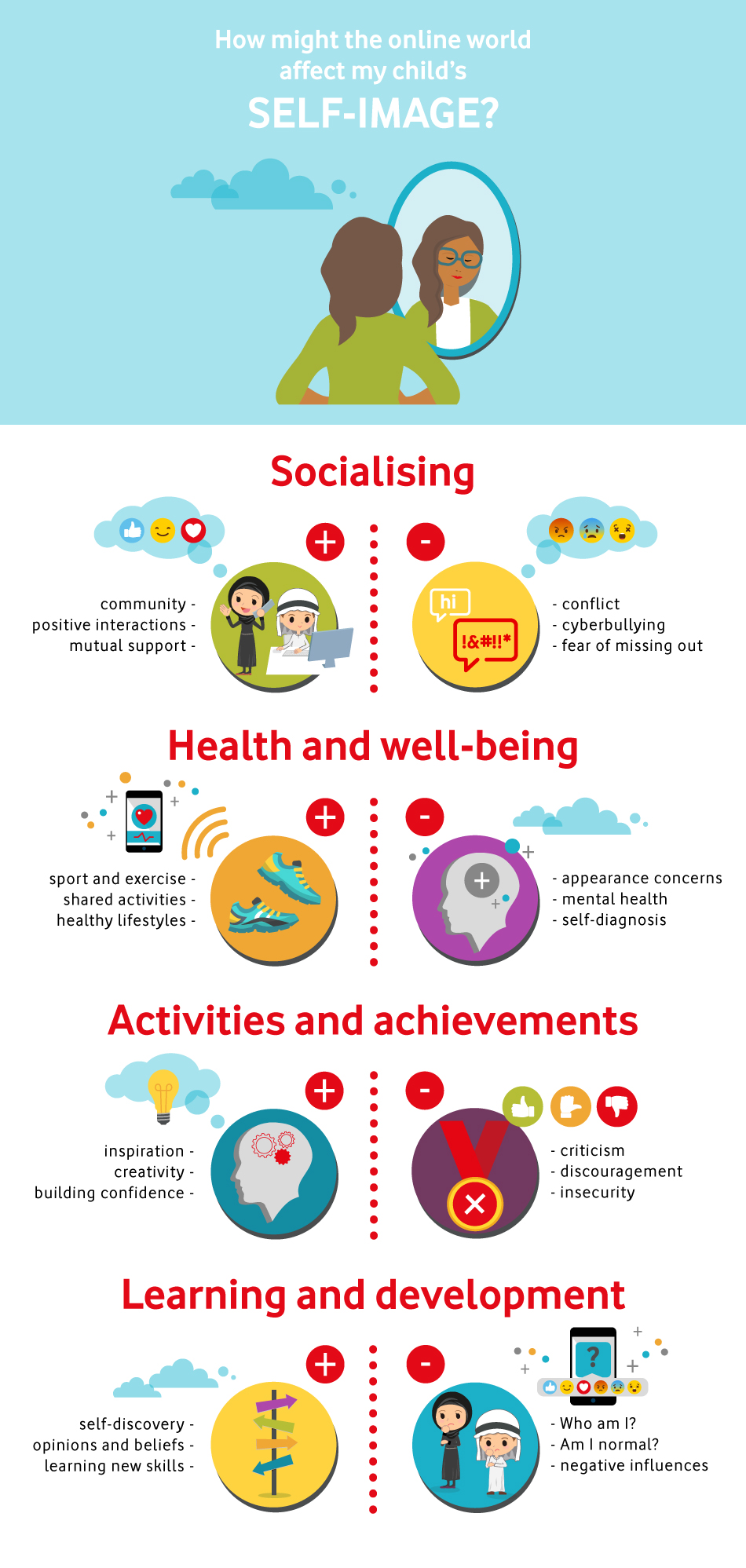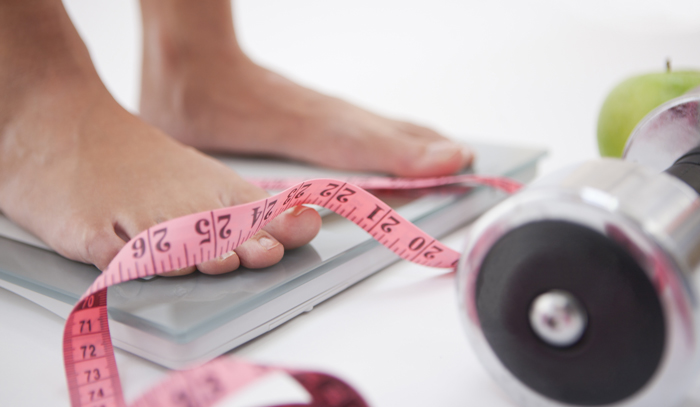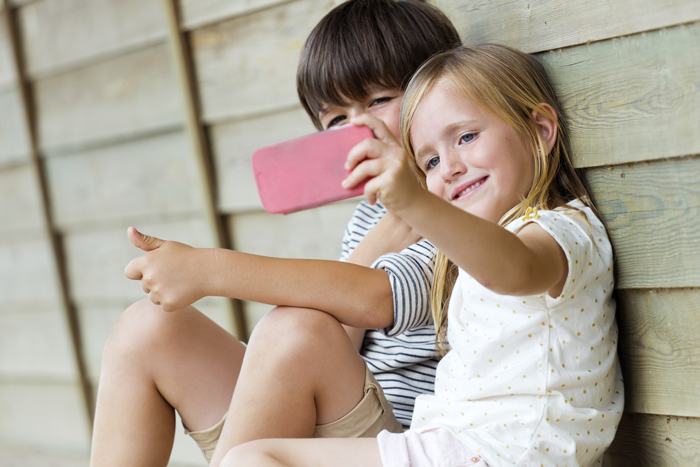Identity, body image, self-esteem…
What do we mean when we talk about self-image?
Elsewhere on the Vodafone AmanTECH website, we have talked about young people’s reputations; the way that other people see them based on how they act both online and offline.
Self-image, on the other hand, is how a person judges themselves.
The key question is this: “What do I believe that other people think about me?”
The impact of the digital world
The online world is often held responsible for all manner of ills, particularly in regards to the mental and physical health of the young people using it. Social media and other aspects of the digital world can certainly create pressures on a person’s sense of self and well-being. What is not true, however, is the idea that the impacts of the internet and social media are only ever negative.
The image below demonstrates just a few of the areas in which our children’s image of themselves and their worth could be affected, and some of the impacts they might have – both positive and negative.

Just as in other areas of life, parents can do a lot to guide their families through these challenges and opportunities. While we may not always feel confident with the technology, we do have experience and wisdom that applies both online and offline.
One key element of digital parenting is to engage with the things that children are doing online and to encourage and help them to find the positive aspects of the internet. As the image above shows, the internet provides lots of opportunities for creativity, development and enjoyment. By taking time to talk about the things that our families enjoy about the digital world, rather than only focusing on the negative, we provide the opportunity for young people to talk about the things that inspire them. The internet can also complement the things that children enjoy doing offline, whether that’s learning new skills like cooking, or getting inspired by sporting heroes or musicians.

Self-image and teenage children
Put simply, self-image is the way that a person sees themselves. It may include their physical appearance, their intelligence, their abilities and skills, and much more. Adolescence is not an easy time; as teenagers change from children into adults they change intellectually, emotionally and physically.Intellectually, young children view the world in black and white; everything is good or bad, right or wrong. As children become teenagers, however, the way that they see the world around them adjusts and they may be faced with uncertainty and confusion for the first time. They may start to disagreeing and even arguing with their parents and teachers as they struggle to understand the world around them and their place in it.
Emotionally, adolescence may be even more confusing – for parents as well as children. Where infants might feel either happy or sad, adolescents suddenly find themselves feeling lots of different things at the same time. Friendship can become more intense, for good and for bad, and the flood of emotions may be overwhelming at times.
Physically, adolescence brings with it a whole host of changes. Teenagers need more sleep as their bodies grow and change shape. At the same time that they are becoming more aware of what other people might think of them, our children have to deal with acne and facial hair. It is no wonder that it can be a difficult time for them!
Of course, as parents we want to do everything we can to support our children as they grow. In order to do that, it is important that we are not only able to understand some of changes our kids are going through; Digital Parents also need to know how the extra pressures that the digital world can place on young people in the 21st century.

Carefree or care-worn?
As adults, it easy for parents to look back at childhood as an idyllic time when they didn’t have a care in the world! For many of us, this was true; however, for many of today’s digital children it is not always the case.
Many things have changed over the last few decades; in particular, our children are being bombarded like never before with commercials, movies, music videos and images that tell them how they ‘should’ think, look and act.
This type of pressure can affect many different areas of our young people’s lives. For example, research over the last few years has shown that:
- In survey of young people in the UAE, 78% of females and 58% of males are not completely happy with the way their bodies look.
- Nearly 20% of young Qatari men have felt peer-pressure and taken part in dangerous stunt driving in front of an encouraging audience, compared to 6.4% of non-Qataris
- The increased use of the internet in Arab Gulf States may be linked to an increase in the number of teenagers and young adults suffering from mental health problems like depression.

West comes east…
In countries like the USA, Australia and the UK, the evidence of a link between an increase in use of the internet and poor self-image is growing. It is only recently, however, that the same thing is being seen in Qatar and the wider Gulf region.
The advantage of the internet is that it gives us access to a digital world, full of information on every topic imaginable. The disadvantage of the internet is exactly the same thing. Children and young people are being influenced by the things that they see and read online, which is directly affecting the way that they view themselves.
For example,a study in Australia found that girls aged 13-15 years who use social networking websites like Facebook were more worried about their body shape than girls who did not use those sites.
The internet gives young people a place to find information and discuss issues, such as relationships, bullying, stress, bereavement, eating disorders like anorexia, and self-harm (hurting themselves deliberately). As Digital Parents, it is important to know what our children may be looking for online and what we can do to help.

How can Digital Parents support their children?
The importance of the way that our children see themselves is a theme that has been picked up in the National Mental Health Strategy.
Her Highness Sheika Moza bint Nasser said that, “Starting with our young people, we must encourage a culture of dialogue and openness about mental health”
As is often the case, the starting point for Digital Parents who want to give their children help and guidance in their digital world is to talk. Beginning that conversation may not be easy, but in the long term it will give them the best possible opportunity to develop a positive self-image despite the pressures of the modern world.
Here are some ideas of how to begin:
Find the right time for a conversation – after school might be the perfect time for a parent to talk, but it may be the worst possible time for a teenager who is upset about a Whatsapp message they received on the way home
Consider whether talking is the way to begin; if your teenage daughter is unhappy about something and doesn’t want to speak about it, perhaps sending a text message to let her know that you care about her is a good way to make a start
Try not to assume that all online interactions with other young people about challenging issues are necessarily harmful; social networking is also a good way for friends to encourage each other when something difficult is happening
Listen to your child’s opinions and concerns about themselves; how they look, what their friends think of them, what kind of person they ‘ought’ to be
Talk to your son or daughter about the places they might look for advice about health and other personal issues online
Encourage them to come to you if they want to talk about anything they’ve come across online that’s troubling them
Finally, if you are concerned that your child may be suffering from negative self-image to the extent that it is affecting their mental or physical health, talk to their doctor or school counsellor about the kind of help that is available.